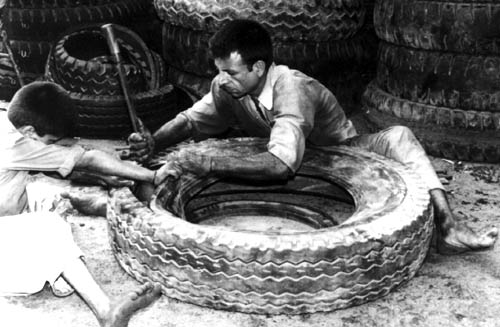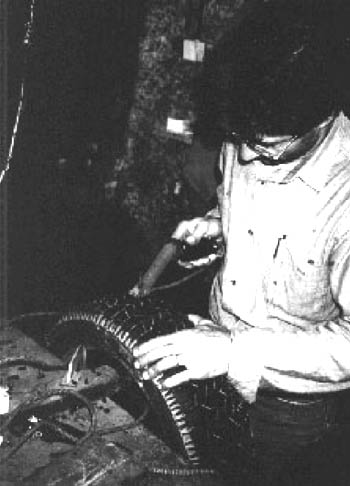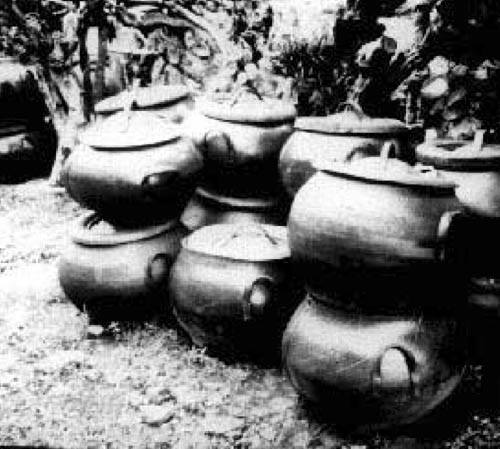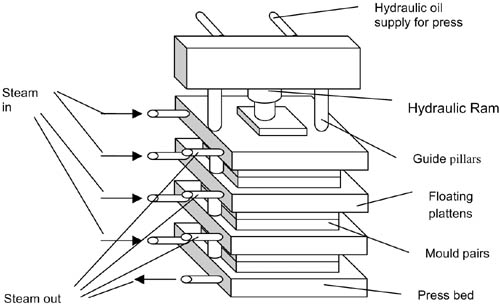How to Recycle Rubber
Contents
- 1 Recycling Rubber - Technical Brief
- 1.1 Short Description
- 1.2 Introduction
- 1.3 What is rubber?
- 1.4 Synthetic Rubber
- 1.5 Vulcanisation
- 1.6 Why reclaim or recycle rubber?
- 1.7 Tyre reuse and recovery in developing countries
- 1.8 Recovery of rubber
- 1.9 References and further reading
- 1.10 Useful addresses
- 1.11 Related Articles
- 1.12 Categories
Recycling Rubber - Technical Brief
Short Description
- Problem:
- Idea:
- Difficulty:
- Price Range:
- Material Needeed:
- Geographic Area:
- Competencies:
- How Many people?
- How Long does it take?
Introduction
Rubber is produced from natural or synthetic sources. Natural rubber is obtained from the milky white fluid called latex, found in many plants; synthetic rubbers are produced from unsaturated hydrocarbons.
Long before Colombus arrived in the Americas, the native South Americans were using rubber to produce a number of water-resistant products. The Spaniards tried in vain to copy these products (shoes, coats and capes), and it was not until the 18th century that European scientists and manufacturers began to use rubber successfully on a commercial basis. The British inventor and chemist Charles Macintosh, in 1823, established a plant in Glasgow for the manufacture of waterproof cloth and the rainproof garments with which his name has become synonymous.
A major breakthrough came in the mid 19th century with the development of the process of vulcanisation. This process gives increased strength, elasticity, and resistance to changes in temperature. It also renders rubber impermeable to gases and resistant to heat, electricity, chemical action and abrasion. Vulcanised rubber also exhibits frictional properties highly desired for pneumatic tyre application.
Crude latex rubber has few uses. The major uses for vulcanised rubber are for vehicle tyres and conveyor belts, shock absorbers and anti-vibration mountings, pipes and hoses. It also serves some other specialist applications such as in pump housings and pipes for handling of abrasive sludges, power transmission belting, diving gear, water lubricated bearings, etc.
In this brief, we will be looking primarily at the reclamation and reuse of scrap tyres. This is simply due to the fact that this is the major source of waste rubber in developing countries.
What is rubber?
Natural rubber is extracted from rubber producing plants, most notably the tree Hevea brasiliensis, which originates from South America. Nowadays, more than 90% of all natural rubber comes from these trees in the rubber plantations of Indonesia, the Malay Peninsula and Sri Lanka. The common name for this type of rubber is Para rubber.
The rubber is extracted from the trees in the form of latex. The tree is 'tapped'; that is, a diagonal incision is made in the bark of the tree and as the latex exudes from the cut it is collected in a small cup. The average annual yield is approximately 2 ½ kg per tree or 450kg per hectare, although special high-yield trees can yield as much as 3000kg per hectare each year.
The gathered latex is strained, diluted with water, and treated with acid to cause the suspended rubber particles within the latex to coagulate. After being pressed between rollers to form thin sheets, the rubber is air (or smoke) dried and is then ready for shipment.
Synthetic Rubber
There are several synthetic rubbers in production. These are produced in a similar way to plastics, by a chemical process known as polymerisation. They include neoprene, Buna rubbers, and butyl rubber. Synthetic rubbers have usually been developed with specific properties for specialist applications. The synthetic rubbers commonly used for tyre manufacture are styrene-butadiene rubber and butadiene rubber (both members of the Buna family). Butyl rubber, since it is gas-impermeable, is commonly used for inner tubes. Table 1 below shows typical applications of various types of rubber.
|
Type of rubber |
Application |
|
Natural rubber |
Commercial vehicles such as lorries, buses and trailers. |
|
Styrene-butadiene rubber (SBR) and Butadiene rubber (BR) |
Small lorries, private cars, motorbikes and bicycles. |
|
Butyl rubber (IIR) |
Inner tubes. |
Table 1: Applications of different classes of rubber in the manufacture of vehicle tyres.
The raw materials that make up tyres are natural and synthetic rubbers, carbon, nylon or polyester cord, sulphur, resins and oil. During the tyre making process, these are virtually vulcanised into one compound that is not easily broken down.
Production of rubber products
The modern process of rubber manufacture involves a sophisticated series of processes such as mastication, mixing, shaping, moulding and vulcanisation. Various additives are included during the mixing process to give desired characteristics to the finished product. They include:
|
Polymers |
Vulcanisation accelerators |
|
Activators |
Vulcanisation agents |
|
Fillers (carbon black) |
Fire retardants |
|
Anti-degradants |
Colorants or pigments |
|
Plasticisers |
Softeners |
Fillers are used to stiffen or strengthen rubber. Carbon black is an anti-abrasive and is commonly used in tyre production. Pigments include zinc oxide, lithopone, and a number of organic dyes. Softeners, which are necessary when the mix is too stiff for proper incorporation of the various ingredients, usually consist of petroleum products, such as oils or waxes; pine tar; or fatty acids. The moulding of the compound is carried out once the desired mix has been achieved and vulcanisation is often carried out on the moulded product.
Vulcanisation
To understand the process of vulcanisation it is worth discussing, briefly, the molecular structure of rubber. Crude latex is made up of a large number of very long, flexible, molecular chains. If these chains are linked together to prevent the molecules moving apart, then the rubber takes on its characteristic elastic quality. This linking process is carried out by heating the latex with sulphur (other vulcanising agents such as selenium and tellurium are occasionally used but sulphur is the most common). There are two common vulcanising processes.
• Pressure vulcanisation. This process involves heating the rubber with sulphur under pressure at a temperature of 150°C. Many articles are vulcanised in moulds that are compressed by a hydraulic press (see Figure 1 below).
• Free vulcanisation. Used where pressure vulcanisation is not possible, such as with continuous, extruded products, it is carried out by applying steam or hot air. Certain types of garden hose, for example, are coated with lead, and are vulcanised by passing high-pressure steam through the opening in the hose.
The proportion of natural and synthetic rubber used for tyre manufacture depends on the application of the particular tyre.
|
Truck tyre tread (in %) |
Passenger vehicle tyre tread (in %) | ||
|
Mineral oil |
13 |
20 - 24 | |
|
Carbon black |
30 |
33 - 37 | |
|
Rubber - of which |
57 |
40 - 45 | |
|
Natural rubber |
65 |
25 | |
|
BR & SBR |
35 |
75 | |
Table 2: Composition of typical tyre tread for commercial and passenger vehicles. (TOOL 1996)
Why reclaim or recycle rubber?
Rubber recovery can be a difficult process. There are many reasons, however why rubber should be reclaimed or recovered;
- Recovered rubber can cost half that of natural or synthetic rubber.
- Recovered rubber has some properties that are better than those of virgin rubber.
- Producing rubber from reclaim requires less energy in the total production process than does virgin material.
- It is an excellent way to dispose of unwanted rubber products, which is often difficult.
- It conserves non-renewable petroleum products, which are used to produce synthetic rubbers.
- Recycling activities can generate work in developing countries.
- Many useful products are derived from reused tyres and other rubber products.
- If tyres are incinerated to reclaim embodied energy then they can yield substantial quantities of useful power. In Australia, some cement factories use waste tyres as a fuel source.
Tyre reuse and recovery in developing countries
There is an enormous potential for reclamation and reuse of rubber in developing countries. There is a large wastage of rubber tyres in many countries and the aim of this brief is to give some ideas for what can be done with this valuable resource. Whether rubber tyres are reused, reprocessed or hand crafted into new products, the end result is that there is less waste and less environmental degradation as a result.
In developing countries, there is a culture of reuse and recycling. Waste collectors roam residential areas in large towns and cities in search of reusable articles. Some of the products that result from the reprocessing of waste are particularly impressive and the levels of skill and ingenuity are high. Recycling artisans have integrated themselves into the traditional market place and have created a viable livelihood for themselves in this sector. The process of tyre collection and reuse is a task carried out primarily by the informal sector. Tyres are seen as being too valuable to enter the waste stream and are collected and put to use.
In Karachi, Pakistan, for example, tyres are collected and cut into parts to obtain secondary materials which can be put to good use. The beads of the tyres are removed and the rubber removed by burning to expose the steel. The tread and sidewalls are separated - the tread is cut into thin strips and used to cover the wheels of donkey carts, while the sidewalls are used for the production of items such as shoe soles, slippers or washers (WAREN Report).

Figure 2: Manual Separation of the Tread from the Sidewalls, Karachi, Pakistan © PCSIR - WASTE
Recovery of rubber
Recovery Alternatives
There are many ways in which tyres and inner tubes can be reused or reclaimed. The waste management hierarchy dictates that re-use, recycling and energy recovery, in that order, are superior to disposal and waste management options. This hierarchy is outlined in Table 3 below.
|
Kind of recovery |
Recovery process | |
|
Product reuse |
Repair |
• Retreading |
|
Physical reuse |
• Use as weight | |
|
Material reuse |
Physical |
• Tearing apart |
|
Chemical |
• Reclamation | |
|
Thermal |
• Pyrolysis | |
|
Energy reuse |
• Incineration |
Table 3: Principal rubber recycling processing paths (adapted from van Baarle)
Product re-use
Damaged tyres are, more often than not, repaired. Tubes can be patched and tyres can be repaired by one of a number of methods. Regrooving is a practice carried out in many developing countries where regulations are slacker and standards are lower (and speeds are lower) than in the West. It is often carried out by hand and is labour intensive.
The use of retread tyres saves valuable energy and resources. A new tyre requires 23L of crude oil equivalent for raw materials and 9L for process energy compared with 7L and 2L respectively for retreading. Tyres of passenger vehicles can generally be retreaded only once while truck and bus tyres can be retreaded up to six times. Retreading is a well established and acceptable (in safety terms) practice. The process involves the removal of the remaining tread (producing tyre crumb - see later) and the application and vulcanisation of a new tread (the 'camel back') onto the remaining carcass. In Nairobi about 10,000 tyres a week are received for retreading (Ahmed).
Secondary reuse of whole tyres is the next step in the waste management hierarchy. Tyres are often put to use because of their shape, weight, form or volume. Some examples of secondary use in industrialised countries include use for erosion control, as tree guards, in artificial reefs (but the ecological soundness of this practice is questionned along with the stability of the material in sea water) , fences, or transformed into playground devices. In developing countries wells can be lined with old tyres, docks are often lined with old tyres which act as shock absorbers, and similarly crash barriers can be constructed from old tyres. Old inner tubes also have many uses; swimming aids and water containers being two simple examples.

Figure 3: Following the grooves is a Labour -intensive process. © Knud Sauer - WASTE
Material re-use
The next step in our hierarchy involves the material being broken down and reused for the production of a new product. As mentioned earlier, in developing countries this hand reprocessing of rubber products to produce consumer goods is well established and the variety of products being made from reclaimed tyres and tubes is astonishing. The rubber used in tyres is a relatively easy material to reform by hand. It behaves in a similar manner to leather and has in fact replaced leather for a number of applications. The tools required for making products directly from tyre rubber are not expensive and are few in number. Shears, knives, tongs, hammers, etc., all common tools found in the recyclers' workshop, along with a wide range of improvised tools for specialised applications. Shoes, sandals, buckets, motor vehicle parts, doormats, water containers, pots, plant pots dustbins and bicycles pedals are among the products manufactured.
Another way in which physical reuse can be achieved is by reducing the tyre to a granular form and then reprocessing. This can be a costly process and there has to be a manufacturer willing to purchase the granules. Crumb rubber from the retreading process can be used in this way, as it is a good quality granulated rubber. The reprocessing techniques used are similar to those described in earlier chapters. Granulate tends to be used for low-grade products such as automobile floor mats, shoe soles, rubber wheels for carts and barrows, etc., and can be added to asphalt for road construction, where it improved the properties of this material.

Figure 4: Garbage containers made from Truck tyres. Manila, The Philippines © CAPS - WASTE
Chemical and thermal recovery
This type of recovery is not only lower in the waste management hierarchy, but is also a higher technology requiring sophisticated equipment. The applicability of such technologies for small-scale applications in developing countries is very limited. We will therefore look only very briefly at a couple of processes. Chemical recovery is the process of heating waste rubber reclaim, treating it with chemicals and then processing the rubber mechanically.
- Acid reclamation - uses hot sulphuric acid to destroy the fabric incorporated in the tyre and heat treatment to render the scrap rubber sufficiently plastic to allow its use as a filler with batches of crude rubber.
- Alkali recovery - Reclaimed rubber, treated by heating with alkali for 12 to 30 hours, can be used as an adulterant of crude rubber to lower the price of the finished article. The amounts of reclaimed rubber that are used depend on the quality of the article to be manufactured.
One form of thermal recovery is pyrolysis. This involves heating the tyre waste in the absence of oxygen which causes decomposition into gases and constituent parts. It is a technology which is still immature in the tyre-reprocessing field.
Energy recovery
Tyres consist of around 60% hydrocarbons, which is a store of energy that can be recovered by incineration. The heat produced can be used directly in processes such as cement making, or to raise steam for a variety of uses, including electricity generation. Again, this technology requires sophisticated plant and its application is limited when looking at small-scale enterprise.
Landfill
Landfill is the final step in the waste management hierarchy. The landfill disposal of tyres, if properly managed, does not constitute an environmental problem. However, concerns about conserving resources and energy have seen an increasing opposition to landfilling. Also, public sanitation and municipal waste management is often ineffective in developing countries and scrap tyres are often found littering the streets.
References and further reading
1. Ahmed, R., Klundert, Arnold van de, Lardinois, I., Rubber Waste, Options for Small-scale Resource Recovery, TOOL Publications and WASTE, 1996. A book aimed at small-scale rubber recyclers in developing countries.
2. Vogler, Jon, Work from Waste, Intermediate Technology Publications and Oxfam, 1981. A classic for those wishing to recycle waste and create employment.
3. Baarle, B. van, Het hervewerken van Rubberafval van Personenevagenbanden (Reuse of Rubber from Passenger Vehicles), NOVEM / RIVM, The Netherlands 1988.
4. "Rubber," Microsoft® Encarta® 98 Encyclopedia. © 1993-1997 Microsoft Corporation. All rights reserved.
5. Scrap Tire and Rubber Recycling Terminology Booklet developed by the ITRA Tire and Rubber Recycling Advisory Council (TRRAC) (See address in following section). It is a valuable resource to understanding the tire industry and tire recycling issues.
6. Porteous, Andrew, Recycling Resources Refuse, Longman 1977.
Internet addresses
http://www.itra.com/corporate/recycling/trrac.htm
International Tire and Rubber Association (ITRA) Home Page. A wealth of information on recycling of tyres and associated topics.
http://www.wrf.org.uk
Web site of the World Resource Foundation (see previous section).
http://www.rapra.net
Web site of RAPRA (see previous section).
http://usrubber.com/
US Rubber Inc. A commercial Website with an interesting range of products from recycled rubber.
This Howtopedia entry was derived from the Practical Action Technical Brief Energy from the Wind.
To look at the original document follow this link: http://www.practicalaction.org/?id=technical_briefs_manufacturing
Useful addresses
World Resource Foundation
Heath House
133 High Street, Tonbridge
Kent TN9 1DH
Tel +44 (0)1732 368333
Fax +44 (0)1732 368337
http://www.wrf.org.uk
'The Warmer Bulletin' published 4 times a year (subscription required)
CAPS
Room 202, Loyola Heights Cond.
Est Abada crnr F de la Rosa St
1109 Loyola Heights, Quezon City
The Philippines.
Contact: Mr. Dan Lapid
Tel: +63 (2) 4345573
Fax: +63 (2) 4345954
Consultants with on-line enquiries, training, info and education.
UNDP / World Bank
Integrated Resource Recovery Programme,
1818 H. Street NW, Washington DC, USA.
Tel: +1 (202) 477 1254
Fax: +1 (202) 477 1052
Publications on policy and case studies
RAPRA Technology Ltd.
Shawbury, Shrewsbury,
Shropshire SY4 4NR
Tel: +44 (0)1939 250 383
Fax: +44 (0)1939 251 118
Technical info centre for rubbers and plastics, consulting and analysis services. Publish Journal 'Progress in Rubber and Plastics technology'
WASTE Nieuwehaven 201,
2801 CW Gouda, The Netherlands.
Tel: +31 (0)182 522 625
Fax: +31 (0)182 550313
Advisers on urban environment and development.
Anne-Lies Risseeuw - Compiles regular Urban Waste Expertise Programme Bulletin
ITRA Tire and Rubber Recycling
Advisory Council, P.O. Box 37203, Louisville,
Kentucky 40233-7203 USA,
Tel: +1 800-426-8835, 502-968-8900
Fax: +1 502-964-7859,
TNO Plastics and Rubber Research Inst.
PO Box 6031, 2600 JA Delft,
The Netherlands.
Tel: +31 (15) 69 66 21
Fax: +31 (15) 56 63 08
Research into plastics and rubber, advice and training.
Environmental Development Action in the Third World,
Head Office: PO Box 3370, Dakar, Senegal.
Tel: +221 (22) 42 29 / 21 60 27
Fax: +221 (22) 26 95
Regional offices in Colombia, Bolivia and Zimbabwe
Database, library, publications and advice.
Quarterly magazine 'African Environment'
Appropriate Technology Development Association,
PO Box 311, Gandhi Bhawan,
Lucknow-226001, U.P.
India.
Research Institute - rubber and plastics
Practical Action
The Schumacher Centre for Technology & Development, Bourton on Dunsmore, RUGBY, CV23 9QZ, United Kingdom.
Tel.: +44 (0) 1926 634400, Fax: +44 (0) 1926 634401
e-mail:practicalaction@practicalaction.org.uk
web:www.practicalaction.org

Related Articles
- How to Recycle Rubber
- How to Recycle Plastic Bags
- How to Pasteurize Water with a Plastic Bottle
- What to Do with Plastic Containers
- How to Make a Tippy Tap for Hand Washing
Two ways to support the work of howtopedia for more practical articles on simple technologies:
Support us financially or,
Testimonials on how you use howtopedia are just as precious: So write us !
<paypal />
Categories
- Construction
- Energy
- Ideas
- Mechanics
- Pest control
- Pollution
- Products
- Recycling
- Resource Management
- Small Business
- Transportation
- Waste
- High Technology
- Easy to Medium
- Global Technology
- Global
- Rural Environment
- Urban Environment
- Oil
- Plastic container
- Tyres
- Neighbourhood
- Principles
- Requested translation to Spanish
- Requested translation to French
- Requested translation to Portuguese
